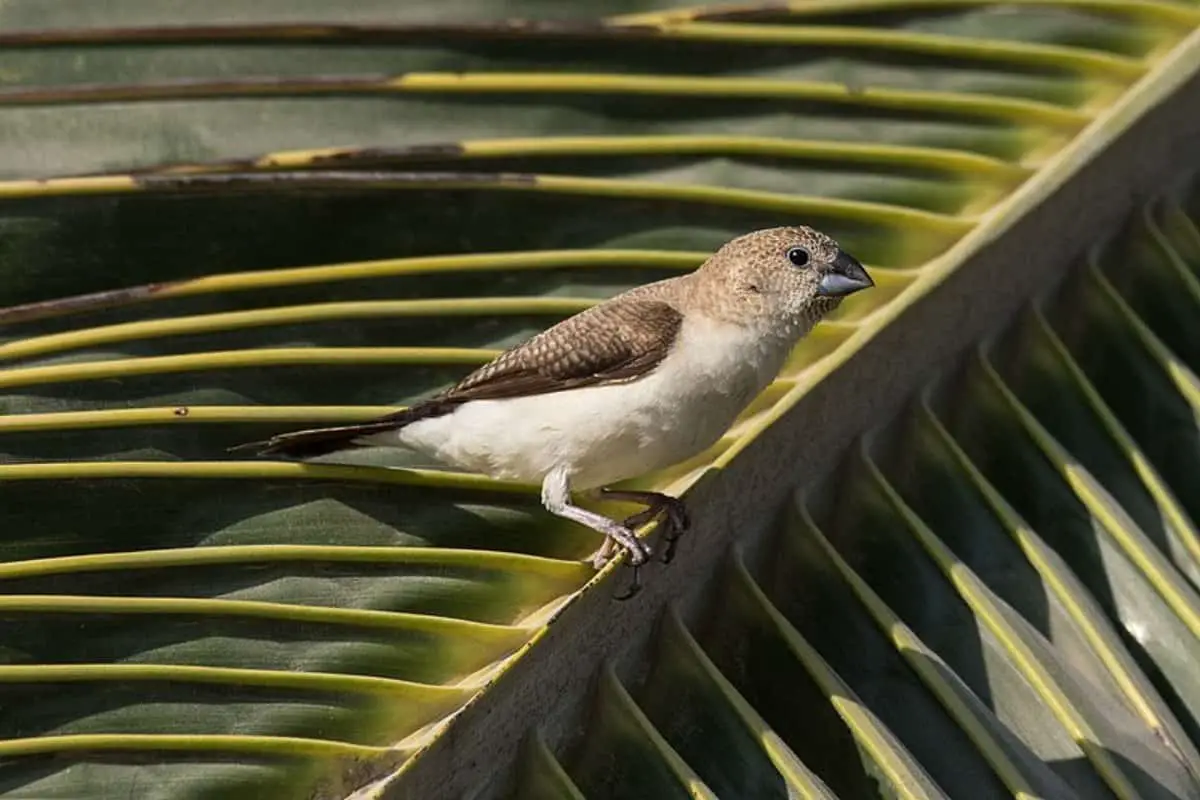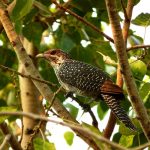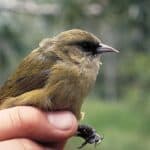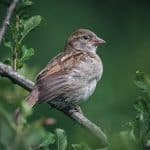Common Name: African Silverbill
Scientific Name: (Euodice cantans)| Size | Diet | Range in Hawaii | Status in Hawaii |
|---|---|---|---|
| 4 in. | seeds | Common on all islands | Least Concern |
The African Silverbill, also known as Euodice cantans, is a small passerine bird species that is native to sub-Saharan Africa. However, it has also been introduced to other parts of the world, including Hawaii, where it has become a naturalized resident.
Although recently established in Hawaii, the African Silverbill has already made a name for itself among bird enthusiasts due to its unique appearance and behavior. In this article, we will explore more about the African Silverbill, its characteristics, and its presence in Hawaii.
African Silverbill
Appearance
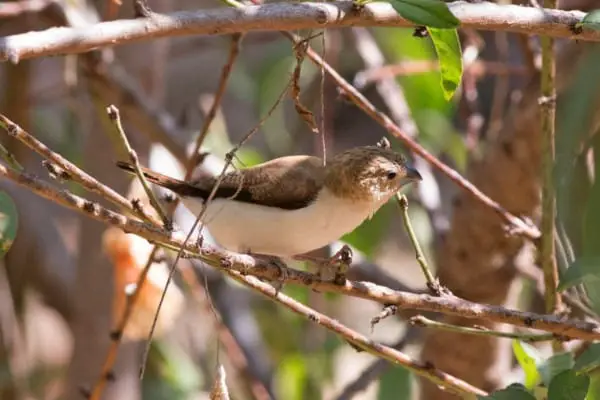
The African Silverbill is a small bird with a distinct appearance. It measures approximately 4 inches (10 centimeters) in length. This species has a compact and plump body, short rounded wings, and a short tail.
The plumage of the African Silverbill is predominantly grayish-brown, with a lighter underbelly. It has a small, conical bill and dark eyes. One of its notable features is its silver-colored bill, which gives the bird its name. The wings and back may display subtle streaks or scalloped patterns, adding to its overall attractive appearance.
Both males and females have similar plumage, making them difficult to distinguish based on appearance alone. Overall, the African Silverbill’s small size, silver bill, and grayish-brown plumage contribute to its distinctive and charming look.
Diet
The diet of the African Silverbill primarily consists of seeds. As seed-eating birds, they have a preference for small grass seeds, including those from various grass species. They also consume seeds from herbaceous plants and weeds.
In addition to seeds, the African Silverbill may supplement its diet with small insects and their larvae, especially during the breeding season when protein-rich food sources are crucial for the development of the chicks. However, seeds remain the mainstay of their diet.
Nesting
The African Silverbill constructs small, cup-shaped nests for breeding purposes. These nests are typically made from a variety of materials, including grasses, fine twigs, and plant fibers. The birds weave these materials together to form a sturdy and compact structure.
The nesting sites of African Silverbills are often located in shrubs, bushes, or tall grasses, providing some protection and concealment for the nest. They may also build nests in man-made structures such as buildings or nests of other bird species, taking advantage of available resources.
Female African Silverbills are responsible for nest construction, while males may assist in gathering materials. The nests are usually placed at varying heights, depending on the surrounding vegetation or structure. Inside the nest, the female lays a clutch of small eggs, typically ranging from 3 to 5 eggs.
Both parents take turns incubating the eggs, sharing the responsibility of keeping them warm until they hatch. After hatching, both parents participate in feeding and caring for the hatchlings. The chicks grow rapidly and leave the nest within a few weeks.
Behavior
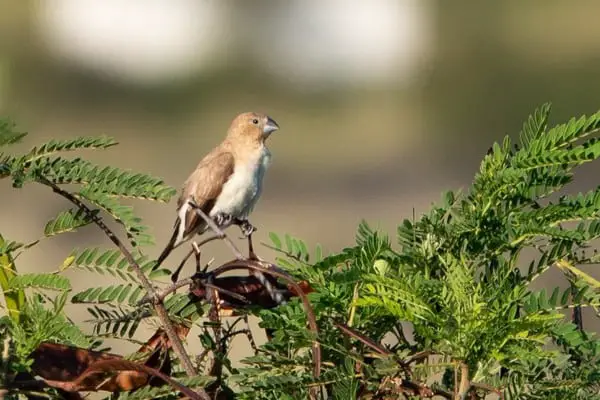
The African Silverbill exhibits social and active behavior. These small birds are often observed in small flocks, where they engage in various interactions and activities. They are highly social within their own species and often communicate through soft chirps and calls.
African Silverbills are primarily ground foragers, hopping and searching for seeds and insects in grassy areas. They use their specialized beaks to crack open seeds and extract the edible portions. Their feeding behavior is often seen in small groups, taking advantage of available food resources.
During the breeding season, African Silverbills engage in courtship displays, which can include fluttering flights, wing flicking, and singing. Males may also perform displays to attract females. Once a pair is formed, both male and female participate in nest building, incubation, and raising the young.
These birds are active throughout the day and spend a considerable amount of time foraging and socializing. They are agile flyers and can make short, swift flights when needed. When not foraging or breeding, African Silverbills often rest and roost in trees or shrubs.
Habitat
The African Silverbill is a bird species that is adaptable to various habitats. They are commonly found in open grasslands, savannas, and agricultural areas. Their habitat preferences include areas with grassy vegetation, shrubs, and scattered trees.
These birds are known to inhabit both natural and human-altered environments. They can be found in open fields, meadows, parks, gardens, and even urban areas. They have successfully adapted to living in close proximity to human settlements.
African Silverbills are often associated with areas where grass seeds and other small seeds are abundant. Such habitats provide them with ample food resources for their seed-based diet. They are also known to frequent areas with weed growth, as these plants often produce seeds that are a part of their diet.
While they are commonly seen in lowland regions, African Silverbills can also occur at higher elevations, depending on the availability of suitable food sources and nesting sites.
Range
The African Silverbill, native to Africa south of the Sahara Desert, was successfully introduced to the Hawaiian Islands in the 1970s. Since then, it has established populations on multiple islands, including Hawaii (Big Island), Maui, Lana’i, Kaho’olawe, Moloka’i, O’ahu, and Kaua’i. They are commonly found in dry habitats, open fields, and coastal areas.
The African Silverbill’s expansion through the Hawaiian Islands indicates its ability to disperse naturally, with observations of individuals crossing open-water channels. They have been recorded in various locations, with high counts noted in different areas over the years.
Conservation Status
The conservation status of the African Silverbill is generally considered to be of “Least Concern” according to the International Union for Conservation of Nature (IUCN). This designation suggests that the species is not currently facing significant threats that would endanger its population on a global scale.
Interesting Facts
1. Social Birds
These birds are highly social and often found in small flocks, engaging in interactions and vocalizations.
2. Active foragers
They are ground foragers, hopping and searching for seeds and insects in grassy areas.
3. Courtship displays
During the breeding season, males perform fluttering flights and wing flicking displays to attract females.
4. Agile flyers
They are capable of swift and agile flight, enabling them to navigate their habitat efficiently.
5. Nesting site adaptation
They may build nests in natural vegetation or utilize man-made structures for nesting purposes.
Frequently Asked Questions
1. Are African Silverbills monogamous?
Yes, African Silverbills are generally monogamous during the breeding season, forming pairs for nesting and raising their offspring.
2. How long do African Silverbills live?
On average, African Silverbills have a lifespan of around 4 to 7 years in the wild. However, with proper care in captivity, they can live up to 10 years or more.
3. Can African Silverbills be kept as pets?
Yes, African Silverbills can be kept as pets, but it’s important to check local regulations and obtain them from reputable sources. Responsible pet ownership and ensuring their needs are met are crucial for their well-being.
